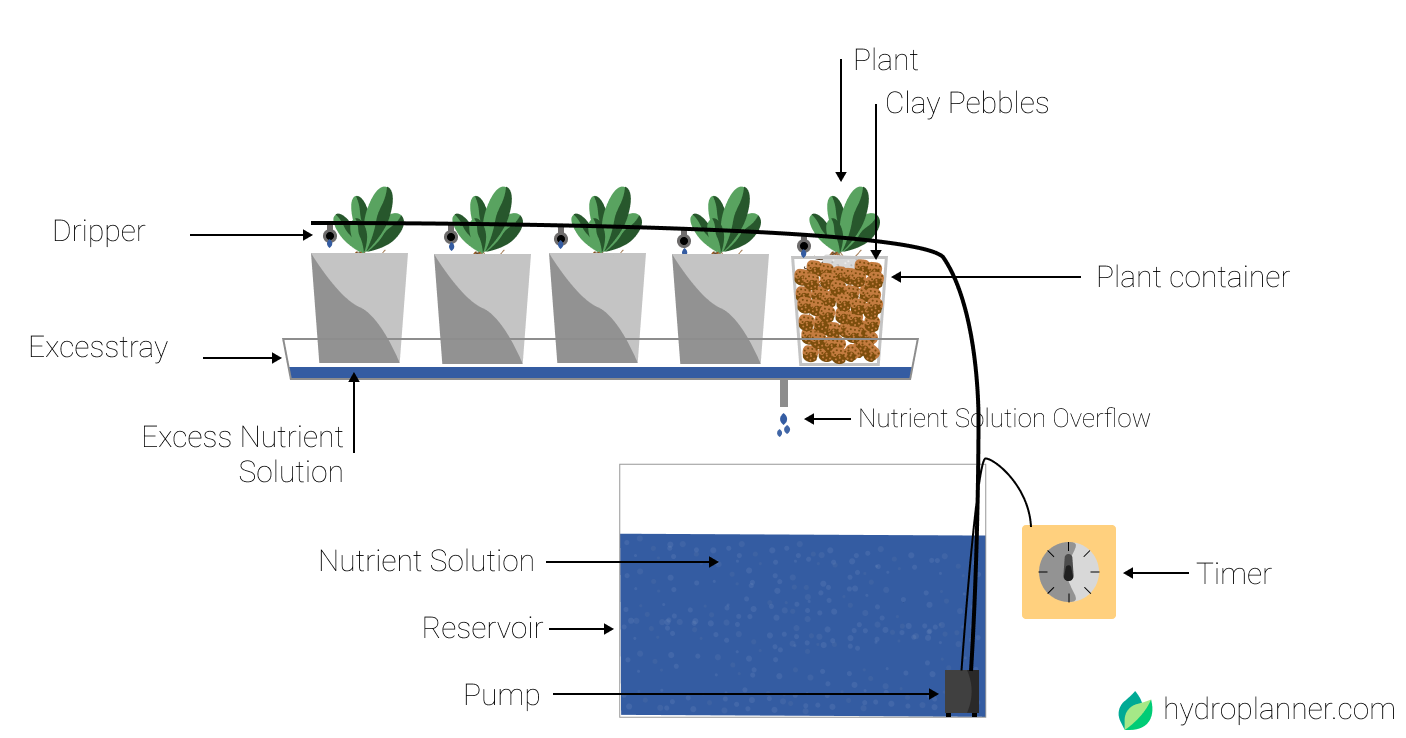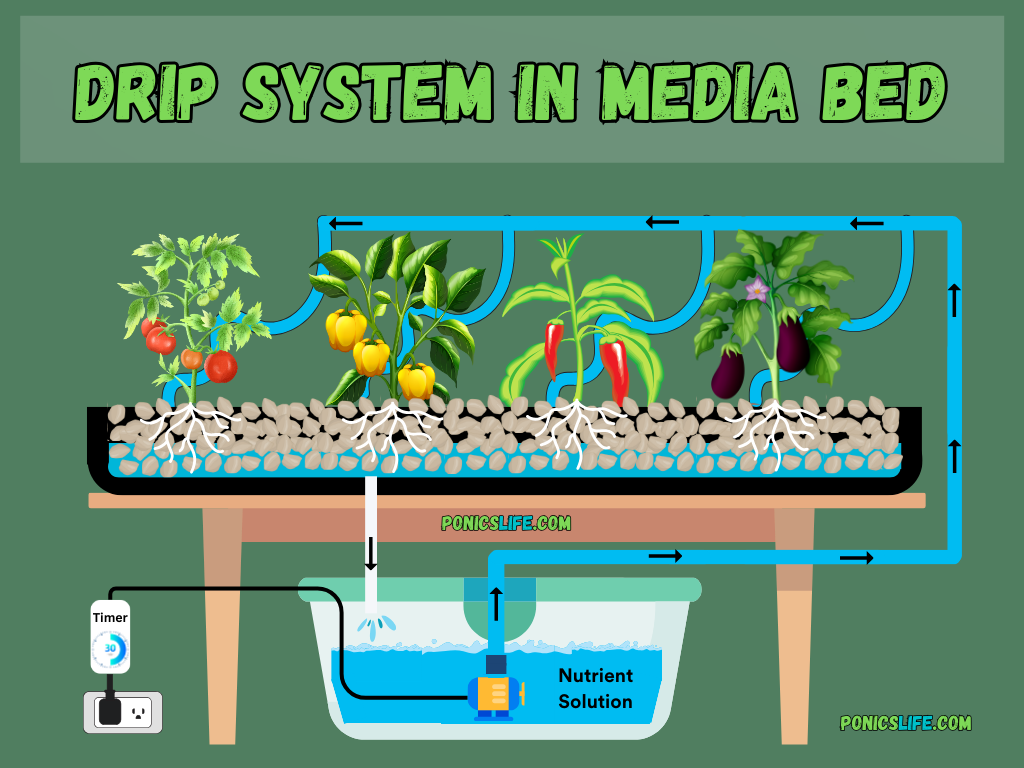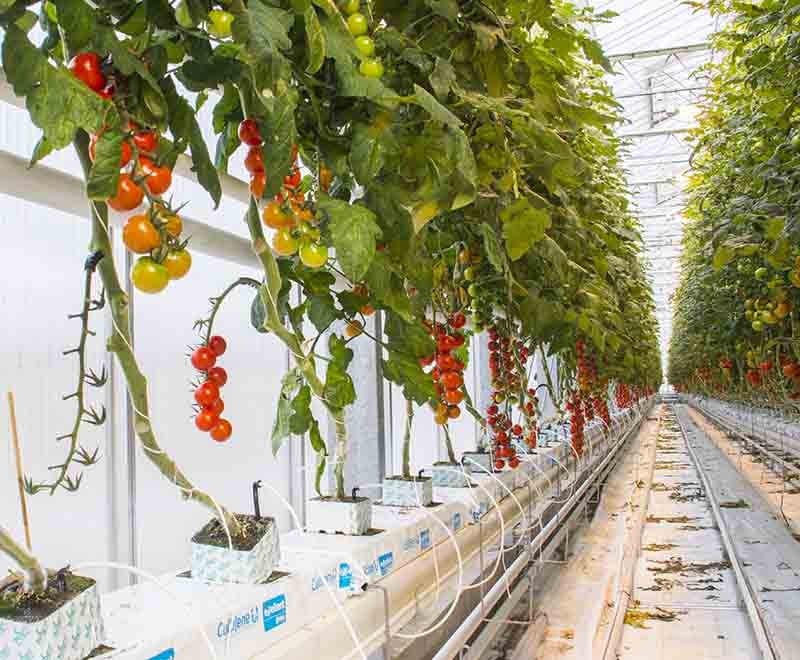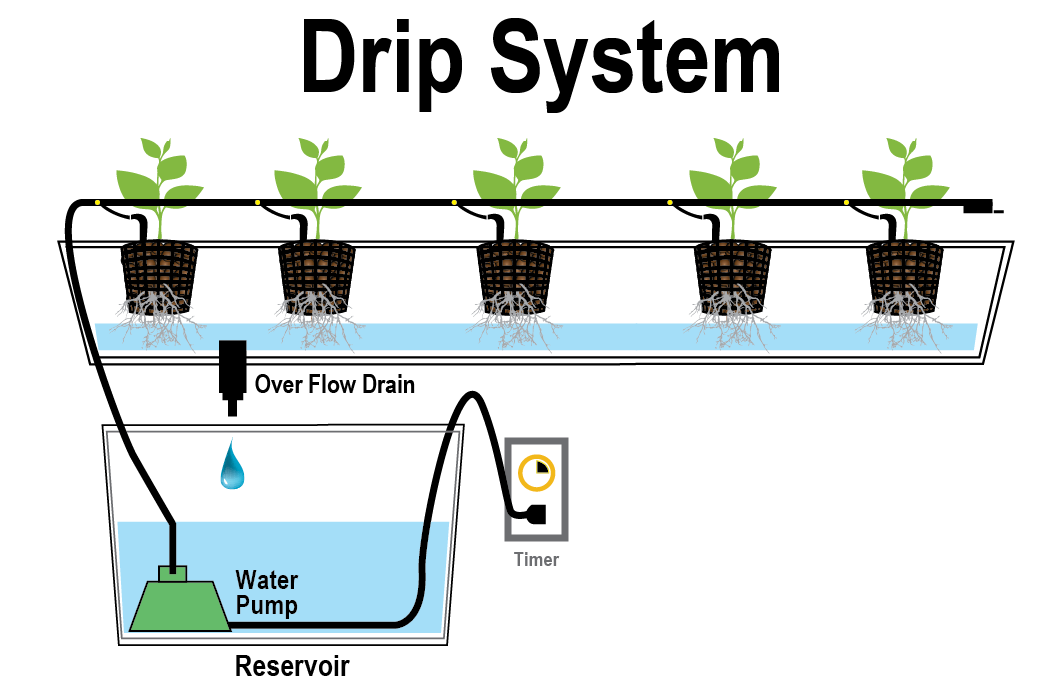Growing plants without soil sounds impossible. But hydroponics makes it a reality.
The hydroponics drip system is a popular method for cultivating plants in a controlled environment. This system delivers nutrients directly to the plant roots, ensuring efficient growth. It’s a fascinating approach that appeals to both hobbyists and serious growers. Why choose a hydroponics drip system?
It offers precision and conserves water. This method is ideal for those wanting to maximize space and resources. Plus, it’s versatile. You can grow a variety of plants, from herbs to vegetables. The system’s simplicity attracts beginners, while its efficiency satisfies experienced gardeners. Dive into this method and discover a world where plants thrive without soil.
Introduction To Hydroponics Drip Systems
Hydroponics drip systems are a popular choice for growing plants. They are efficient and versatile. This system delivers nutrient-rich water directly to plant roots. It uses a network of tubes and emitters. This method saves water and nutrients. It also promotes healthy plant growth. Hydroponics drip systems are suitable for beginners and experts alike. They offer a controlled environment for plant cultivation.
Basics Of Drip Irrigation
Drip irrigation is a precise watering method. It involves delivering water slowly to the base of each plant. Emitters control the water flow. This reduces water waste. It ensures each plant receives adequate moisture. The system uses pumps, timers, and tubing. These components work together to automate the process. Drip irrigation is ideal for conserving water.
Benefits Of Hydroponics
Hydroponics offers several benefits. It uses less water than traditional gardening. Plants grow faster and healthier. They receive direct nutrients without soil. This reduces disease risk. Hydroponics allows year-round farming. It is suitable for small spaces. It eliminates the need for pesticides. This results in cleaner produce. Hydroponics drip systems are efficient and productive.

Credit: hydroplanner.com
Components Of A Drip System
A hydroponics drip system includes essential components such as a reservoir, pump, drip lines, and emitters. Nutrient-rich water flows from the reservoir through the pump, reaching plants via drip lines. Emitters deliver water directly to plant roots, ensuring efficient nutrient absorption and healthy growth.
Understanding the components of a hydroponics drip system is crucial for anyone looking to dive into this innovative method of gardening. Whether you are a seasoned gardener or a beginner, knowing what makes up your drip system can help you grow healthier plants. Each component plays a unique role, ensuring your plants get the nutrients they need.Reservoir Setup
The reservoir is the heart of your hydroponics drip system. It holds the nutrient solution that feeds your plants. When setting up your reservoir, consider its size. It should be large enough to hold sufficient water and nutrients for your plants. Keep in mind the location as well. A shaded spot prevents algae growth, which can hinder plant health. Using a lid can also keep debris and light out, maintaining a clean solution.Pump And Tubing
The pump and tubing work together to deliver nutrients from the reservoir to your plants. A reliable pump ensures a steady flow, preventing nutrient build-up or plant starvation. Choose a pump that matches the size of your system for optimal performance. Tubing, often overlooked, is equally important. Opt for tubing that is flexible yet durable to withstand daily use. Properly routing your tubing can prevent kinks and ensure even distribution of nutrients. Have you ever considered how these components impact your plant’s growth? Proper maintenance and thoughtful setup can significantly boost your garden’s productivity. Engage with your system, make adjustments, and witness your plants thrive.Selecting The Right Plants
Choosing the right plants for a hydroponics drip system is crucial. Different plants have unique requirements and growth patterns. Some thrive in drip systems while others may not. Understanding which plants suit this method can lead to success. Consider factors like growth rate, space, and nutrient needs.
Best Plants For Drip Systems
Leafy greens are excellent choices. Lettuce, spinach, and kale grow well. Herbs like basil, mint, and cilantro flourish too. Tomatoes and peppers are popular for their adaptability. Strawberries can be a sweet addition to your system. These plants are known for efficient water uptake.
Considerations For Growth
Space is vital. Ensure you have enough room for plant expansion. Nutrient needs vary; some plants require specific minerals. Regular monitoring helps maintain health. Light exposure affects growth; ensure adequate lighting. Temperature control is crucial for optimal plant health.
Designing An Efficient System
Crafting an effective hydroponics drip system involves precise control over nutrient delivery and water flow. This system ensures plants receive optimal hydration and nutrients, promoting healthy growth without soil. Efficient design minimizes waste and maximizes plant yield, offering a sustainable gardening solution.
Designing an efficient hydroponics drip system can seem like a complex puzzle, but breaking it down into key components makes it manageable. The goal is to create a system that maximizes plant growth while minimizing resources. This approach not only boosts your yield but also ensures sustainability, saving you time and effort in the long run.Optimal Layout Strategies
An optimal layout is crucial in a hydroponics drip system. Start by considering the size and shape of your growing space. A rectangular arrangement often works well, allowing easy access to plants and ensuring even distribution of nutrients. Think about the flow of water and nutrients. A closed-loop system can be more efficient, recycling unused resources back into the system. This not only conserves water but also reduces the need for constant nutrient replenishment. Have you thought about how this might affect your setup?Spacing For Maximum Yield
Proper spacing is essential for achieving maximum yield. Crowding plants can hinder growth by limiting light and air circulation. Measure the full-grown size of your plants to determine appropriate spacing. Consider using adjustable racks or shelves to accommodate different plant sizes. This flexibility allows you to optimize space as your plants grow. How might this adaptability benefit your harvest? Be mindful of the type of plants you’re growing. Some require more room to thrive, while others can be planted closer together. Tailoring your spacing strategy to the specific needs of your plants can lead to a more bountiful harvest. Designing an efficient hydroponics drip system is about making informed choices. By focusing on layout and spacing, you can create a thriving environment for your plants. What changes will you make to your system today?Nutrient Solutions And Management
Hydroponics drip systems provide plants with essential nutrients directly to their roots. This system ensures efficient nutrient use and water conservation. It’s a sustainable method for growing healthy plants indoors or outdoors.
Nutrient solutions are the lifeblood of any hydroponics drip system. They supply essential minerals and elements needed for plant growth. Managing these solutions effectively is crucial to ensure your plants thrive.Choosing Nutrient Mixes
Selecting the right nutrient mix can feel overwhelming. With so many options available, it’s important to choose one tailored to your plant species. Think about your plants’ specific needs and growth stages. You might start with a balanced mix for general use. As you gain experience, you can customize the blend. This experimentation can lead to better growth and healthier plants.Monitoring Nutrient Levels
Regularly checking nutrient levels is key to avoiding deficiencies or toxicities. Use a nutrient meter to measure the concentration of the solution. This helps you adjust the mix if needed. Consider setting a schedule for checks. Routine monitoring keeps you informed about your plants’ health. It also gives you the chance to catch issues early. Have you ever tested your nutrient levels only to find them way off? It’s a reminder of how quickly conditions can change. Regular monitoring helps you stay ahead and maintain balance. Managing nutrient solutions might seem daunting at first. But with practice, it becomes second nature. Keep learning, and your plants will show the results.
Credit: ponicslife.com
Maintenance And Troubleshooting
Ensuring smooth operation of a hydroponics drip system involves regular cleaning and checking for clogs. Monitor water flow to prevent uneven distribution, which can hinder plant growth. Troubleshoot issues promptly to maintain optimal plant health and system efficiency.
Maintaining a hydroponics drip system can be a fulfilling task, ensuring your plants thrive effortlessly. Imagine walking into your garden every day, greeted by lush greenery and vibrant blooms. But what happens when things go wrong? Understanding the intricacies of maintenance and troubleshooting is essential for a flourishing hydroponic garden.Regular System Checks
Regular checks are the backbone of a healthy hydroponics drip system. Start by inspecting the tubing for any clogs or leaks. A small blockage can halt nutrient flow, affecting plant growth. Next, monitor your water reservoir. Check the pH and nutrient levels frequently. Unbalanced levels can lead to poor plant health. Adjust as needed to keep your plants thriving. Don’t forget the pump and timer. Ensure they’re functioning correctly. A malfunctioning pump can disrupt the nutrient delivery, and an inaccurate timer can throw off your watering schedule.Common Issues And Fixes
Even with regular checks, issues can arise. One common problem is algae growth in the reservoir. This can be tackled by covering the tank to block out light or using an algaecide. Clogged emitters can be frustrating. If you notice uneven water distribution, clean the emitters with a mild acid solution to clear any mineral build-up. Pump failures can be daunting. If your pump stops working, check the power source and ensure the pump is not overheating. A simple reset or cleaning can often resolve the issue. Maintenance and troubleshooting may seem daunting, but it can be quite manageable. Do these checks make your hydroponic journey easier? Share your thoughts and experiences in the comments below!Environmental Control
Environmental control is crucial when setting up a hydroponics drip system. It is the backbone of achieving optimal growth and yield from your plants. By managing temperature, humidity, and light, you create a balanced ecosystem that supports healthy plant development. Let’s delve into these essential aspects.
Temperature And Humidity
Maintaining the right temperature and humidity can make or break your hydroponic garden. High temperatures can stress plants, while low temperatures can stunt growth. Aim for a comfortable range between 65 to 75 degrees Fahrenheit for most plants. Use a digital thermostat to monitor and adjust as needed.
Humidity levels are equally important. Most plants thrive with 50-70% humidity. Too much moisture can encourage mold, while too little can dry out leaves. I once lost an entire batch of basil due to unchecked humidity spikes. Consider using a hygrometer to keep track and a humidifier or dehumidifier to adjust levels.
Light Requirements
Light is the lifeline of any plant. In a hydroponics drip system, you need to ensure plants receive adequate light without overheating. LED grow lights are a popular choice; they provide the right spectrum without excessive heat. Position them 12-18 inches above the plants for optimal exposure.
Adjust the light duration based on the plant type. Leafy greens may need 14-16 hours of light, while fruiting plants might require 18 hours. Don’t overlook the importance of darkness. Plants need rest too. Set up a timer to automate light cycles, ensuring consistency and preventing human error.
Are you optimizing your environmental controls effectively? Consider what adjustments might improve your plant growth today. Small changes can lead to big results in your hydroponics journey.

Credit: www.trees.com
Future Trends In Hydroponics
Exploring the hydroponics drip system reveals exciting advancements in sustainable agriculture. This system precisely delivers nutrients to plants, enhancing growth efficiency. Future trends highlight its potential for urban farming, offering fresh produce solutions in limited spaces.
The world of hydroponics is evolving rapidly, promising exciting changes in how we grow our food. As more people turn to this innovative method, understanding future trends becomes crucial. These trends not only impact efficiency but also the sustainability of our planet. What can you expect from the future of hydroponics? Let’s dive in.Advancements In Technology
Technology is transforming hydroponics into a high-tech industry. Imagine using sensors to monitor plant health in real-time. This technology helps you adjust nutrients and water, optimizing plant growth. Automation is another game-changer. Automated systems can control light and temperature, ensuring plants thrive without constant human intervention. Have you thought about using artificial intelligence in your garden? AI can predict plant diseases before they occur, saving your crops. It’s like having a personal plant doctor at your fingertips. These advancements make hydroponics more accessible and efficient for everyone.Sustainability And Growth
Sustainability is at the heart of modern hydroponics. With resources dwindling, hydroponics offers a way to grow more using less. This method uses up to 90% less water than traditional farming. You can grow crops in urban areas, reducing the need for transportation and lowering carbon emissions. Vertical farming is another trend to watch. By stacking layers of crops, you maximize space, even in small areas. This method can feed growing urban populations without expanding farmland. Are you ready to contribute to a greener future? Hydroponics might be your answer. These future trends in hydroponics are not just about improving plant growth. They’re about creating a sustainable, efficient system that benefits everyone. What part will you play in this green revolution?Frequently Asked Questions
What Is The Drip System In Hydroponics?
A drip system in hydroponics delivers nutrient-rich water directly to plant roots. It uses drip emitters to control water flow. This setup promotes efficient nutrient uptake and growth. Ideal for beginners, it’s adjustable and prevents overwatering, ensuring optimal plant health.
What Is The 30/30 Rule For Drip Irrigation?
The 30/30 rule for drip irrigation involves running the system for 30 minutes, allowing soil to absorb water for 30 minutes. This technique promotes efficient water use and healthier plant growth. Adjust timing based on specific plant needs and soil conditions for best results.
What Are The Disadvantages Of A Drip System?
Drip systems can clog easily and require regular maintenance. Initial setup costs are high. They may not cover large areas efficiently. Water distribution can be uneven, affecting plant growth. System components can be damaged by sunlight or animals.
What Are 3 Disadvantages Of Hydroponics?
Hydroponics can be expensive due to initial setup costs. It requires constant monitoring and maintenance for optimal growth. The system is vulnerable to power outages, which can disrupt plant health.
Conclusion
Hydroponics drip systems offer an efficient way to grow plants. They use less water than traditional methods. Roots receive nutrients directly, promoting healthy growth. These systems are suitable for small spaces. They require minimal maintenance and provide consistent results. Hydroponics can be a rewarding hobby.
It allows you to grow fresh produce at home. Experimentation can lead to better yields. With time, one can master techniques for optimal growth. Start small and watch your garden thrive. Enjoy the benefits of hydroponics and fresh, healthy plants.





